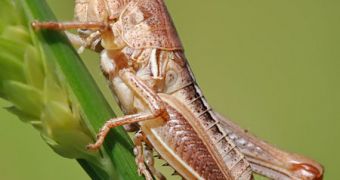Research scientists from the Arizona State University traveled around the world, to the most isolate places on the planet, to determine what is it exactly that triggers the swarming behavior in locusts. The creatures can produce massive damages to crops and trees, and so figuring out how to stop them is essential for agriculture.
Numerous species of insects are known to swarm, for a variety of reasons. Bees do it when one of them detects an intruder, whereas ants do so when its time for a queen to make its nuptial flight. But the reason why locusts start swarming has until now remained elusive.
In the past, these creatures were a real problem. Back in the days when people where living off the fat of the land, and had nothing extra to spare, losing a harvest to the locusts equaled death in most cases. This is why swarms have religious connotations in some parts of the world.
In spite of interacting with humans for centuries, no one has been able to determine why locusts act the way they do. Confusing researchers even further is the fact that several species of the creatures prefer to remain solitary, whereas others gladly come together to start swarming.
Understanding why this happens has been the objective of ASU zoologist and PhD student Arianne Cease for the past 24 month. She has been traveling to northeastern China to analyze the locust species Oedaleus asiaticus.
The creature dominates the grasslands of the area, and has been linked to some pretty devastating swarming events in the past. Cease was as much interested in analyzing the insects themselves, as she was in studying their direct effect on their natural habitat and environment.
“It is one of just 20-30 species of grasshoppers worldwide that have the capability of gathering and creating a migratory swarm. But in order to do this, the grasshopper as a juvenile must be exposed to certain environmental stimuli,” the expert explains.
In order for the insects to develop a migratory phenotype, it must be exposed to communities since day one. A phenotype is the full ensemble of traits that a living organism owes to its genetic heritage and environmental factors.
This early exposure to other locusts and grasshoppers makes the young ones more willing to congregate when they reach maturity, as opposed to renaming solitary like other species do.
“Anecdotally we know that swarms are associated to the brown phenotype, not the green ones. We found out that the brown ones do have bigger flight muscles and bigger wings,” Cease explains.
Details of the new investigation were published in the August issue of the esteemed Journal of Insect Physiology. The work was conducted with grant money from the US National Science Foundation (NSF).

 14 DAY TRIAL //
14 DAY TRIAL //